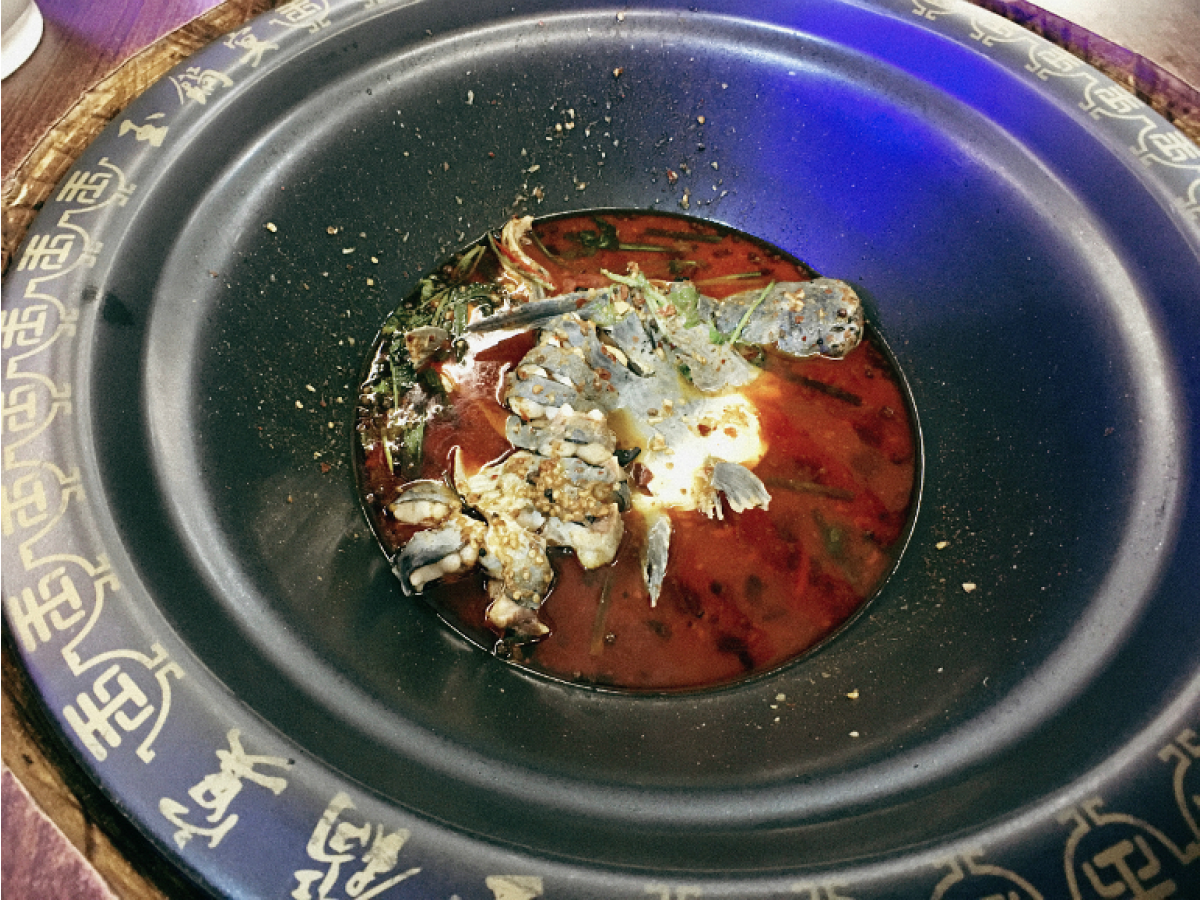Taste Known Source Steam Stone Fish: It’s a mouthful but what a taste!

Before anything, we have to address the elephant in the room: the restaurant is actually called “Taste Known Source Steam Stone Fish”.
Yes, it is a mouthful but it sounds a lot better when you say it in Mandarin — Wei Zhi Yuan Zhen Qi Shi Guo Yu. Loosely translated, it means something along the lines of — “the original well-known taste of ‘steam stone fish'” which is exactly the speciality of this Sichuan restaurant located on Pagoda Street, the main tourist strip in Chinatown.
Steam Stone Fish
Fairly well-known in Sichuan province, the dish is often marketed with the story of how it became part of Sichuan cuisine, which goes something like this: back in the Qing Dynasty when China was ruled by Emperor Qian Long (1711-1799), the Emperor went on a trip to Chang Sha in Southern China and was impressed by a fish soup which was served in an earthen stone pot in one of the eateries. He liked the dish so much that he named it “Good Fortune Fish”.
Traditionally, the soup is boiled over a fire in a stone pot packed with natural minerals. The minerals seep into the soup and you get extra nutrients as a result.
At Taste Known Source Steam Stone Fish, they have adapted the concept by placing a whole raw fish (sea bass, snapper and the like; $28 to $48) and a mala (Sichuan spice mix) concoction into a stone pot with a steam outlet at its base. The outlet pumps hot steam into the pot, and after six minutes, the fish comes out perfectly steamed and the broth lightly simmering.
You can order a variety of steamboat ingredients like cabbage, black fungus and pork belly which you cook in the simmering broth like a traditional Sichuan steamboat hotpot after you’ve eaten the fish.
According to the chef/owner Tang De Hai, the advantages of the hot steam method is that — unlike other Sichuan hot pots which use an open flame — the hot steam keeps the broth piping hot and adds moisture at the same time, so the broth doesn’t dry out or get too salty towards the end of your meal. An ingenious method and true enough, as the meal goes on, the taste of the broth stays consistent throughout.
The flavour of the broth is how a good mala broth should be. Made with a myriad of spices such as Sichuan bean paste, dried Sichuan chillies and peppercorns, garlic and xiang liao (aromatic spices) including liquorice, green cardamom, star anise and cinnamon sticks, the taste has an oil-richness, the right amount of spiciness with that numbing peppercorn sensation and a complex savouriness that mixes black bean paste and stock flavours.
The only flavour missing is the taste of rendered beef fat which is traditionally the only oil used in a Sichuan hot pot but has since given way to vegetable oil as diners have become more health-conscious over the years.
Besides “Hot & Spicy” which is the original flavour and is what most Sichuan fans will order here, they also have a whole host of other flavours ranging from lobster and Sichuan hot & sour to more interesting regional flavours like Duo Jiao which is more Hunan and consists of chopped red chillis brined and a resultant salty, sour flavour.
The level of spiciness can also be customised — level one for a mild spiciness to level three for the real deal.
Chef Tang
Judging by its clientele, the two-year-old restaurant seems to get a fair number of regular followers, and a lot of it has to do with its chef-owner Tang, a 48-year-old Sichuan native who has over 30 years of cooking experience. Besides being the senior chef trainer and adviser for the illustrious National Culinary Training School in Sichuan, he was the first master chef at Si Chuan Dou Hua in 2002 and has started up some of Singapore’s top Sichuan restaurants like Lao Sichuan and Ba Yu Ren Jia.
The menu at Taste Known Source Steam Stone Fish runs the gamut of popular Sichuan dishes as well as general Chinese favourites like sweet sour pork and chilli crab (it is a tourist belt after all), and there are two particular dishes which impressed us the most.
Chong Qing Spicy Chicken
First is the Chong Qing Spicy Chicken ($18.80) which is exceptional and has been a signature wherever Chef Tang goes. We would go so far to say that it is the best la zi ji that can be found in Singapore. Marinated in doubanjiang (Sichuan chilli bean paste), diced chicken is nicely deep-fried with a juicy texture and is tossed in a mountain of Sichuan peppercorns, dried chilli, ginger slices, spring onions, with sesame seeds and groundnuts. Try just the chicken alone, and you’ll be hit by all the accompanying spices. The overall effect is savoury, spicy, aromatic, numbing and it’s a dish you’ll remember fondly for days after.

Ya Bah Tu
This dish is something you’ll see on the tables of hardcore Sichuan food fans, but you won’t know how to order it unless you read Chinese. In English, it says Live Frog with Dried Chilli and Chilli Padi ($25.80), but the Mandarin name “Ya Bah Tu” (deaf mute rabbit) explains the dish a bit better.

Cooked in a style similar to the more famous Shui Zhu Yu (water cooked fish), intense spices and hot boiling oil is poured over poached frog meat and vegetables but here, the fresh (not dried) green variety of peppercorns — which are directly imported from Sichuan — are used, and it gives the dish an intense aroma.
The flavour is incredibly spicy, and the numbing effect which you get from the peppercorns is incredibly bold here. The addition of sweet leeks helps round out the big savouriness of the dish.
Back in Sichuan, this dish would be served with rabbit which explains the name of the dish but as getting a supply of rabbit meat in Singapore is almost non-existent, says Chef Tang, so he substituted frog meat instead. Beef and chicken can also be used instead.




